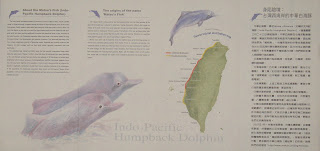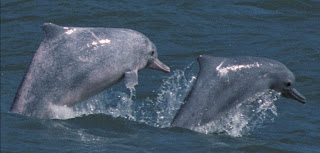
The
Matsu's Fish Conservation Union released a new Taiwan pink dolphin conservation pamphlet for the Second International Workshop on the Conservation and Research Needs of the Indo-Pacific Humpback Dolphins,
Sousa chinensis, in the waters of western Taiwan. Below is the text of the pamphlet.
Pamphlet Text:Indo-Pacific Humpback DolphinWho will help the Matsu Fish? Sousa chinensis The plight of the Indo-Pacific Humpback Dolphin Threats to the Indo-Pacific Humpback Dolphin Since Taiwan started to industrialise in the 1960s, the unrelenting development of the west coast has involved coastal land reclamation, air and water pollution and the cutting-off of water resources, reducing and degrading the dolphins' habitat and indirectly depleting their food sources. Meanwhile, they are also the victims of bycatch through excessive fishing using gill nets (drift nets, trammel nets and bottom-set gill nets) and bottom trawling, of injuries from boat collisions, and of damage to their sonar systems caused by the noise of marine and coastal zone engineering. All these threats have left these dolphins in a state of crisis – there are now only about one hundred or fewer left.
The dolphins’ most important habitat is the coastal waters between Miaoli and Chiayi counties and within five kilometers from shore, which happen to overlap with the locations of major past and current development projects. These include the petrochemical industry (Mailiao Offshore Industrial Park and the Kuokuang Petrochemical Park), heavy industry (the Formosa Plastics and Chunglong Steel Mills) and power generation (the Tongshiao, Taichung, Longjing, Jhanggong and the Longfong Power Plants). Some of these projects are reducing the dolphin’s habitat through land reclamation. And now, Taiwan Power Company is planning to construct offshore wind turbines in this area, slicing up the dolphin’s habitat further still. There are also the Central Taiwan Science Park effluent discharge pipes, Jiji Weir and the planned Dadu and Babao Weirs, and the Hushan Dam, which affect water quality and quantity.
Is the Indo-Pacific Humpback Dolphin being protected? The Indo-Pacific humpback dolphin is classified under Taiwan’s Wildlife Conservation Act as receiving the highest level of legal protection. Sadly, however, the dolphins have never felt the effects of this law, leaving them neglected and under serious threat.
Internationally, not only is the Cetacean Specialist Group of the IUCN in discussions to list this Taiwanese dolphin population as CR (Critically Endangered) in the IUCN Red List, but also it is generally recognized in numerous international cetacean conservation action plans that, in the rapidly developing Asian region, Indo-Pacific humpback dolphin populations are facing major challenges to their continued survival. Conservation action cannot be delayed, and the task of removing human threats must be given the highest priority.
Update: The Eastern Taiwan Strait humpback dolphin is now officially classified as Critically Endangered by the IUCN. See: Critically Endangered - It's Official !
About the Matsu Fish (Indo-Pacific Humpback Dolphin)The Indo-Pacific humpback dolphin is commonly known as Matsu’s Fish, and its scientific name is
Sousa chinensis. It appears mostly in tropical to warm-temperate areas of the Indian and western Pacific oceans, and is often seen along the south-east coast of China. When it is born, the dolphin is grey, but in its youth the colour fades and it becomes patterned with blue-grey spots, and upon reaching adulthood, its whole body becomes white or pink. According to the latest research, the Taiwanese population differs from those in the coastal waters of Hong Kong and China in the development and patterns of spotting. The Taiwanese population may be a unique subspecies endemic to Taiwanese waters. Scientists are currently continuing the research on their ecology, such as their body colour, genetics, population size and distribution.
The statistical data dating from 2002, when the first scientific observations were made along the west coast of Taiwan, to 2007, show that about 50 individuals have been identified so far. Line transect surveys have provided a best estimate of 99 individuals but recent work employing mark-recapture analyses of photographically identified individuals suggests there may be many fewer dolphins in the population. Living in such close proximity to humans, the species is especially vulnerable to threats from human activities. Because of the uniqueness of this population, the Taiwanese population (also known as the Eastern Taiwan Strait population) is rare so the threats to these dolphins can have enormous consequences for this valuable resource.
The origins of the name ‘Matsu’s Fish’ The Taiwan Strait is influenced by the north-easterly wind, and for three quarters of the year, the turbulent sea is covered in whitecaps, making observation difficult. After about the middle of the third month of the lunar calendar, the sea becomes calmer, and the dolphins become easier to distinguish from the waves. The birthday of the sea goddess Matsu falls around this time, on the 23rd of the third month of the lunar calendar. Therefore, it is said that these dolphins appear in the area to wish Matsu a happy birthday.
Stories have been told of occasions when the dolphins have saved drowning people, or warned and protected bathing tourists from sharks. From an ecological perspective, the humpback dolphin is at the top of the food chain, so its survival also represents the stability of the local ecology, and the abundance of fish. Therefore, Han Taiwanese living on the coast have associated their most important goddess, Matsu, with this dolphin, which is both lovable and, further still, an indicator of the health of the coastal environment and coastal people of Taiwan.
Taiwan habitat distribution map Sousa chinensis Confirmed distribution (red)
Possible distribution (yellow)
 What we would like to do
What we would like to do On 28 January 2007, seven Taiwanese NGOs set up the ‘Matsu's Fish Conservation Union’ in response to the crisis.
Now, we hope that with a greater understanding of the basic ecology and conservation crisis of the dolphins, proper conservation concepts for these dolphins can be brought to the public through education and interpretation activities. On-site visits to their habitat, allowing close-up observation of their activity (without disturbing the animals), will allow the public to witness the current state of the surrounding environment, and understand the urgency of conservation work. The proceeds will be used to help fund academic conferences and international exchange, in order to raise levels of conformity and exchange between countries. Because it has been long neglected by academia, and was only discovered by scientists in 2002, knowledge of their most basic ecology is still lacking, meaning that there is a great need for further research. Therefore, funds will also be used to support such fundamental scientific research.
Conservation of Taiwan’s humpback dolphins needs the long term involvement of a large number of people, who will need a stable and independent source of funds. This means it is necessary to seek public donations. We are also considering boosting our conservation fundraising efforts by using a small initial investment taken from our donation funds to develop related products, which will be fun to play with and have collector’s value. In addition, we plan to publish educational books about dolphins, to spread the word about marine ecological conservation.
Our hopeWe hope to bring public, academic, official and international attention to Matsu’s Fish, raising concern for them and encouraging action from all sides. We hope that the government will set real conservation plans, as has been done for endangered species such as the Formosan landlocked salmon, the Black- faced Spoonbill and the Formosan black bear, and support effective implementation of these plans and long-term monitoring, in order to remove the threats to these humpback dolphins, and to let us cherish these marine companions of ours for generations to come.
Please support us Account name: Wild at Heart Legal Defense Association
Bank: Mega International Commercial Bank, Cheng Chung Branch
Account number: 017-09-15465-1
Please write on your donation slip: ‘Matsu's Fish Conservation Campaign’
This campaign welcomes regular credit card contributions, no matter how large or small - please download the authorization form from our blog:
(
Online Donations)
http://www.wretch.cc/blog/twsousaSecretariat for the Matsu's Fish Conservation Union Wild at Heart Legal Defense AssociationTelephone: +886 (0)2 23825789 Fax: +886 (0)2 23825810
12F, 86 Chongcing South Road Section 1, Taipei City 10045, Taiwan.











